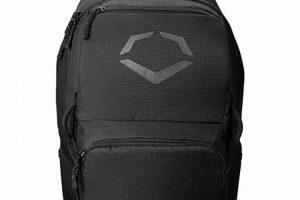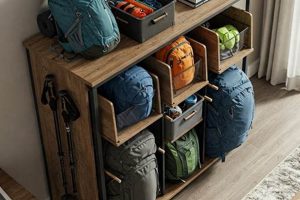A single-shoulder bag, also known as a sling bag, is designed to be carried across the body with a single strap resting on one shoulder. This carrying style differs from traditional backpacks that utilize two straps for weight distribution across both shoulders. Examples include messenger bags, some types of cross-body bags, and smaller daypacks intended for light loads.
The appeal of this bag design lies in its ease of access and perceived style. It allows for quick retrieval of contents without fully removing the bag. Historically, variations of this design have been used by messengers and couriers needing to carry items while maintaining mobility. The comfort and practicality depend heavily on the weight of the contents and the design of the strap and bag structure.
The subsequent sections will delve into various aspects of single-strap carrying bags, including their ergonomic considerations, the range of available designs and materials, and their suitability for different uses and activities. We will also examine the potential drawbacks and offer guidance on selecting the most appropriate single-strap bag for individual needs.
Single-Strap Bag Usage Guidance
The following recommendations aim to maximize comfort and minimize potential strain when utilizing a single-strap carrying bag.
Tip 1: Minimize Load Weight: The asymmetrical design inherently places more stress on one side of the body. Keeping the contents lightweight is crucial. Prioritize essential items only.
Tip 2: Alternate Shoulder Position: Periodically switch the bag to the opposite shoulder. This distributes the load and prevents fatigue on a single muscle group.
Tip 3: Adjust Strap Length: A shorter strap generally keeps the bag closer to the body, improving balance and reducing swing. Experiment to find the optimal length.
Tip 4: Utilize Chest or Waist Straps (if available): Some designs incorporate a secondary strap for added stability. Engage these straps to prevent excessive movement and distribute weight across the torso.
Tip 5: Choose Wide, Padded Straps: A wider strap increases the contact area, reducing pressure on the shoulder. Padding provides additional cushioning and comfort.
Tip 6: Consider Bag Shape and Size: Opt for a bag that conforms to the body’s contours. Avoid overly large bags that encourage overpacking. A streamlined shape reduces snagging and improves maneuverability.
Tip 7: Distribute Contents Evenly: Arrange items within the bag to maintain a balanced weight distribution. Place heavier items closer to the back panel to minimize strain.
Adhering to these guidelines will help mitigate potential discomfort and promote proper posture while using a single-strap carrying bag. Prioritizing a lightweight load and even distribution of weight are crucial for minimizing strain.
The following section will address the suitability of single-strap bags for various activities and lifestyles, allowing for informed decisions regarding their application.
1. Asymmetrical weight distribution
The fundamental characteristic of a single-strap bag, also referred to as a “backpack one strap,” is its inherent asymmetrical weight distribution. Unlike traditional backpacks that distribute load evenly across both shoulders, a single-strap bag concentrates the entire weight on one side of the body. This design necessitates a counterbalancing effort from the user’s musculoskeletal system to maintain equilibrium. The resulting uneven load can lead to muscular imbalances, postural deviations, and increased risk of strain or injury, especially when the bag is heavily loaded or carried for extended periods. The placement of weight dictates the bodys compensation, and the backpack one strap design can put undo stress in a non-ideal manner.
The importance of understanding asymmetrical weight distribution in relation to single-strap bags is crucial for mitigating potential adverse health effects. Consider, for example, a student regularly carrying textbooks in a single-strap bag. The consistent loading on one shoulder could contribute to the development of scoliosis, muscle spasms, or chronic pain over time. Similarly, a commuter carrying a laptop and other essentials daily in a single-strap bag might experience shoulder impingement or neck stiffness due to the altered biomechanics. It is therefore essential to manage the weight, alternate shoulder used, and maintain proper posture.
In conclusion, asymmetrical weight distribution is an unavoidable consequence of the single-strap bag design. Recognizing this inherent challenge is paramount. Minimizing the load, alternating carrying sides, and employing proper carrying techniques are vital strategies for mitigating the potential health risks associated with using a single-strap bag. The understanding of the potential consequences of asymmetrical loading is crucial in promoting responsible use and minimizing long-term physical strain.
2. Quick accessibility
The design of the “backpack one strap” inherently prioritizes quick accessibility to its contents. Unlike traditional backpacks, which require removal for access, the single-strap design facilitates a simple swing-around motion, positioning the bag within reach of the user’s hand. This accessibility is a defining characteristic and a primary motivator for choosing this style of bag, providing immediate access to items without complete disengagement. Consider, for example, a photographer using a single-strap bag to carry equipment. The ability to quickly swing the bag forward allows for rapid lens changes or camera retrieval in dynamic shooting environments.
The importance of quick accessibility extends beyond mere convenience. In certain professions and activities, it can be crucial for efficiency and safety. A bike messenger, for instance, relies on the ability to quickly access delivery documents or communication devices while navigating urban environments. Similarly, a student moving between classes may value the ease of retrieving textbooks or notes without the delay of removing a traditional backpack. The enhanced accessibility also plays a role in security. The ability to keep the bag within constant view, by positioning it on the front of the body, potentially deters theft and provides a heightened sense of control over belongings. The single strap design makes this easy to pull forward as needed.
In summary, quick accessibility is a core functional attribute of the “backpack one strap,” influencing its suitability for specific user needs and scenarios. While the design presents ergonomic considerations, the trade-off for enhanced accessibility often outweighs these concerns, particularly in situations demanding speed and efficiency. The value of this quick access, however, needs to be balanced against the design’s inherent asymmetrical weight distribution and potential for musculoskeletal strain.
3. Ergonomic considerations
Ergonomic considerations are paramount in evaluating the suitability and safety of any carrying device, and are particularly critical when assessing the “backpack one strap” design. The single-strap configuration introduces unique biomechanical challenges compared to traditional backpacks, necessitating careful attention to design features and usage practices that minimize potential strain and discomfort.
- Shoulder Strap Design
The shoulder strap’s width, padding, and adjustability are key ergonomic factors. A wider strap distributes pressure over a larger surface area, reducing localized stress on the shoulder. Adequate padding provides cushioning and minimizes friction. Adjustability allows the user to customize the strap length for optimal bag positioning and weight distribution. Insufficient strap design can lead to shoulder impingement, nerve compression, and muscle fatigue.
- Bag Weight and Distribution
The total weight carried in a “backpack one strap” directly impacts the strain on the supporting shoulder and spine. Heavier loads exacerbate the asymmetrical weight distribution, increasing the risk of muscle imbalances and postural deviations. Careful packing and even distribution of contents within the bag are essential to minimize uneven stress. Limiting the overall weight is a primary ergonomic consideration.
- Body Posture and Alignment
The single-strap design inherently encourages compensatory postural adjustments to maintain balance. Users often lean to the opposite side to counteract the bag’s weight, leading to spinal curvature and muscle imbalances. Conscious effort to maintain proper posture and alignment is crucial to mitigate these effects. Exercises targeting core strength and back muscles can help improve postural stability.
- Carrying Duration and Frequency
The duration and frequency of carrying a “backpack one strap” contribute significantly to ergonomic stress. Prolonged or frequent use without adequate rest periods increases the risk of fatigue and injury. Intermittent switching of the bag to the opposite shoulder can help distribute the load and reduce strain on a single side of the body. Limiting carry time and incorporating rest breaks are recommended ergonomic practices.
The interplay of these ergonomic factors significantly influences the overall comfort and safety of using a “backpack one strap.” A well-designed bag, coupled with conscious attention to weight management, posture, and carrying duration, can mitigate potential risks. Conversely, neglecting ergonomic considerations can lead to a range of musculoskeletal issues, highlighting the importance of informed selection and responsible usage practices.
4. Material Durability
Material durability is a critical factor determining the lifespan and reliability of a single-strap bag. Given the inherent stress concentrations associated with its design, the materials used must withstand significant wear and tear to ensure long-term functionality and prevent premature failure. Material selection directly impacts the bag’s ability to resist abrasion, tearing, and environmental degradation.
- Fabric Strength and Weave
The type of fabric and its weave pattern significantly influence the bag’s resistance to tearing and abrasion. High-density nylon fabrics, often with ripstop weaves, provide excellent tear resistance, preventing small punctures from spreading. Canvas, while durable, can be heavier and more susceptible to moisture damage. The choice of fabric should align with the intended use and environmental conditions.
- Strap and Attachment Point Reinforcement
The single strap and its attachment points are subject to the greatest stress in a single-strap bag. Reinforcement with durable stitching, metal hardware, and additional layers of fabric is crucial to prevent strap detachment or tearing. Failure at these points renders the bag unusable. High-quality thread and robust construction techniques are essential.
- Hardware Quality (Buckles, Zippers, and Fasteners)
Buckles, zippers, and fasteners are integral components that contribute to the bag’s overall durability. Low-quality hardware is prone to breakage, corrosion, and malfunction, compromising the bag’s functionality and security. Metal hardware generally offers greater durability than plastic alternatives. Zippers should be robust and smoothly operating to prevent snagging or separation.
- Water Resistance and Environmental Protection
Depending on the intended use, water resistance can be a crucial aspect of material durability. Water-resistant coatings or laminated fabrics protect the bag’s contents from moisture damage. UV resistance prevents fabric degradation and fading from prolonged exposure to sunlight. The choice of materials should reflect the expected environmental conditions and the need for protection against the elements.
In conclusion, material durability is a primary determinant of the longevity and performance of a single-strap bag. Selecting high-quality materials and employing robust construction techniques are essential to withstand the stresses inherent in the design and ensure long-term reliability. Compromising on material quality can lead to premature failure and dissatisfaction, highlighting the importance of prioritizing durability when choosing a single-strap bag.
5. Carrying capacity
The carrying capacity of a single-strap bag, or “backpack one strap,” is a critical determinant of its suitability for various tasks and its impact on the user’s physical well-being. It dictates the volume and weight the bag can accommodate, directly influencing the ergonomic stresses placed on the shoulder and spine. A higher carrying capacity, while seemingly advantageous, can lead to overloading, exacerbating the asymmetrical weight distribution inherent in the design and increasing the risk of musculoskeletal strain. Conversely, a limited carrying capacity restricts the bag’s utility for tasks requiring transport of multiple or bulky items. Consider, for example, a student using a single-strap bag with a small carrying capacity for textbooks. While it might suffice for a single class, the student would be forced to carry additional items separately, negating the bag’s convenience, or overload the bag, causing postural problems. The understanding of carrying capacity relative to intended use is, therefore, paramount.
The practical significance of understanding the carrying capacity of a single-strap bag extends to various professional and recreational contexts. A photographer, for instance, selecting a single-strap camera bag must consider the capacity required for camera bodies, lenses, and accessories. Overestimation leads to unnecessary bulk, while underestimation necessitates carrying additional equipment separately, undermining the quick accessibility advantage of this design. Similarly, a commuter using a single-strap messenger bag for work must carefully assess the capacity needed for laptops, documents, and personal items to avoid exceeding the bag’s structural limits or placing undue stress on their shoulder. The specific carrying needs must inform the decision regarding bag selection to optimize both functionality and comfort. The carrying capacity becomes important in the sense of weight management as well.
In summary, the carrying capacity represents a key design trade-off in “backpack one strap” bags. While a larger capacity offers greater utility, it also increases the risk of overloading and exacerbating ergonomic problems. Balancing carrying capacity with intended use, weight management, and ergonomic considerations is essential for safe and effective use. Challenges arise when users underestimate the volume or weight of items they regularly carry, leading to improper bag selection and potential physical strain. An informed decision-making process, based on a clear understanding of carrying needs and bag limitations, is crucial for maximizing the benefits and minimizing the risks associated with single-strap bags.
Frequently Asked Questions
The following addresses common inquiries concerning single-strap bags, aiming to provide clear and concise answers to facilitate informed decisions.
Question 1: Is the ‘backpack one strap’ design ergonomically sound for daily use?
The single-strap design inherently introduces asymmetrical weight distribution, potentially leading to muscle imbalances and postural issues. While convenient, it is not generally recommended for carrying heavy loads or prolonged use without careful consideration of weight management and proper posture.
Question 2: How does the carrying capacity of a ‘backpack one strap’ impact its suitability?
Carrying capacity directly affects the weight placed on the single shoulder. A higher capacity can lead to overloading, increasing strain and discomfort. The carrying capacity should be carefully matched to the intended load to minimize ergonomic stress.
Question 3: What materials are best suited for a durable ‘backpack one strap’?
High-density nylon fabrics with ripstop weaves offer excellent tear resistance. Reinforcement at stress points, such as strap attachments, is crucial. Quality hardware, including buckles and zippers, enhances overall durability.
Question 4: Can the shoulder be switched with a ‘backpack one strap’ design?
Yes. Periodically switching the bag to the opposite shoulder is highly recommended. This practice helps distribute the load and prevent fatigue or strain on a single muscle group over an extended period.
Question 5: Are there any alternatives to mitigate the weight on one shoulder for ‘backpack one strap’ design?
A chest strap is one possible solution. Some designs incorporate a secondary strap to improve stability. The engagement of these straps will help in distributing the weight of the bag across the torso.
Question 6: Is a ‘backpack one strap’ design appropriate for children?
Due to the potential for postural problems and muscular imbalances, the ‘backpack one strap’ design is generally not recommended for children, particularly when carrying schoolbooks or other heavy items. A traditional backpack with two straps is more suitable for distributing weight evenly.
Careful consideration of the single-strap bags advantages and disadvantages, particularly regarding ergonomics and weight distribution, is essential for responsible use and minimizing potential adverse effects.
The following section provides advice on selecting a single-strap bag that aligns with individual needs and usage patterns.
Conclusion
This exploration has underscored the complexities associated with the “backpack one strap” design. While offering quick accessibility and a distinct aesthetic, it presents inherent ergonomic challenges related to asymmetrical weight distribution. Material durability and appropriate carrying capacity remain critical considerations to mitigate potential strain and ensure long-term usability. Prioritizing informed selection and responsible usage is imperative to minimize risks.
The “backpack one strap” should be recognized as a design choice demanding careful consideration of individual needs and potential consequences. Acknowledging its limitations and implementing strategies to mitigate strain are crucial for responsible adoption. Future design innovations may address the inherent ergonomic challenges, but, until then, users must exercise caution and prioritize their well-being.







